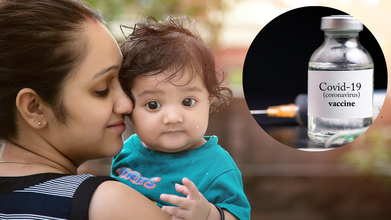- Health Conditions A-Z
- Health & Wellness
- Nutrition
- Fitness
- Health News
- Ayurveda
- Videos
- Medicine A-Z
- Parenting
- Web Stories
Want To Know The Secret To Raising A Successful Child? It Starts At Home With The Mother’s Happiness

Image Credit: Canva
Children are sponges, picking up the behaviors and feelings of those around them, particularly their mothers. For one mother, the moment of realization came when she saw that her daughter was observing and learning everything—how she approached relationships, how she dealt with emotions, and how she established love and self-worth. That moment defined every choice she made, reaffirming a fact backed up by research: a mother's happiness is the number one predictor of a child's success.
Maternal satisfaction, usually quantified as subjective well-being, includes emotional well-being, satisfaction with life, and fulfillment. Maternal satisfaction is a function of numerous factors such as financial stability, social support systems, mental well-being, and work-life balance. Research, for instance, conducted at Ohio State University, verifies that children born to happier mothers are more likely to perform well academically, have better cognitive skills, and have fewer behavioral issues.
Cognitive and Emotional Development
Kids brought up in a home with a contented mother are likely to have better problem-solving abilities, greater emotional intelligence, and a positive learning attitude. When a mother takes care of herself, she creates a situation where her child feels safe, cared for, and motivated to excel.
Moreover, maternal happiness influences emotional stability. Children reflect their parents’ emotional states, meaning a mother who manages stress and prioritizes joy instills emotional resilience in her child. The result? A child who approaches challenges with confidence and composure.
The Behavioral Connection
A mother's joy is also a primary factor in determining the behavior of a child. The more joyful the mother, the more patient, caring, and involved she is, resulting in a warm and not tense home. This stability greatly minimizes the risk of anxiety, hostility, and other behavioral issues among children.
Successful parenting techniques also derive from maternal happiness. Mothers who are happy and emotionally stable tend to be more consistent in their discipline, provide praise, and communicate openly—ingredients for the confident and well-adjusted child.
How to Support Mothers for Brighter Futures and Kids?
Understandably recognizing the pivotal position of happiness in mothers, it becomes a priority to ensure mothers get the support they require. The most important factors that promote a mother's well-being are:
Mental Health Resources: Access to counseling, therapy, and stress management initiatives.
Work-Life Balance: Family-friendly policies that allow flexible work hours and parental leave.
Social Support: Family networks, family support, and peer support groups.
Financial Stability: Financial security that alleviates stress and enables mothers to provide more for their children.
The mother who had worried about bringing up her daughter in a "broken home" discovered that a broken relationship is not a broken life. Rather, by putting herself first and taking care of herself, she gave her daughter the greatest gift: a model of self-worth, resilience, and emotional health.
A happy mother isn't solely about her—it's the key to a child's success. When mothers are successful, their children thrive, showing that a happy mother indeed builds a successful future.
Can You Stop Your Kid From Being Allergic To Peanuts? New Study Shows It May Be Possible With These Steps

(Credit-Canva)
Allergies are a major concern for parents, as they can develop at any time. Parents often worry about being in a situation where they cannot help their child. This leads them to be very cautious of certain foods like peanuts, which is a common allergen, according to the American College of Allergy, Asthma and Immunology.
However, there may be a way to reduce the risk of your child developing peanut allergy. According to a new study published in the Pediatrics journal, giving pediatricians a few simple tools significantly increased how often they recommended introducing peanuts to babies early.
This finding is a major victory because it shows a clear way to prevent peanut allergies, which are becoming more and more common in children. This important study was conducted by experts from Northwestern University and Ann & Robert H. Lurie Children's Hospital of Chicago.
What Age Should Kids Start Consuming Peanut Products?
As you may know, allergies happen when your immune system overreacts to something that is usually not harmful. Things like pollen, pet dander and certain foods like peanuts. Some symptoms of allergies can range from sneezing, a runny nose, vomiting or even difficulty breathing.
Harvard health explains that you can develop allergies at any age. Since 2017, official national medical guidelines have told doctors to recommend giving infants peanut-containing foods when they are around 4 to 6 months old. The reason for this early introduction is to actively lower the baby's risk of developing a peanut allergy.
Despite these clear rules, surveys showed that most pediatricians were not consistently following the guidelines. This is a serious issue because peanut allergy is the most common food allergy in children, and it now affects over 2% of all children in the United States, a number that is currently increasing.
How Can We Lower The Rate Of Peanut-Allergies?
The new study tested an intervention where doctors were given three easy-to-use tools:
- A short training video for the doctor's office staff to watch.
- Electronic health record (EHR) prompts—these are reminders that automatically pop up on the computer screen during a check-up.
- Handouts with clear information for the baby's parents.
The results were impressive: in the clinics that used these tools, doctors followed the guidelines 84% of the time for low-risk babies (those without existing eczema or egg allergy). In contrast, the clinics that did not use the tools only followed the guidelines 35% of the time. This means that babies whose doctors used the tools were nearly 15 times more likely to receive this important allergy prevention advice.
What Role Do Doctors Play To Lower Peanut Allergies?
Lead author Dr. Ruchi Gupta emphasized that this extra support for doctors is absolutely essential. Visits for 4- and 6-month-old babies are often very busy, with many things for the doctor to cover in a short time. The simple tools help doctors provide clear, consistent guidance to families despite this time pressure.
Dr. Gupta shared her hope: "We want these conversations to help parents feel confident and secure about introducing peanut products early." The ultimate goal is to use this effective prevention strategy to stop the trend of rising food allergies in the U.S. and protect children's health.
Covid Vaccine Shortage Puts Children Under 12 at Risk Across the US, Parents Struggle

Credits: Canva
COVID-19 vaccine hunt for young children in the US has now become a task, as pharmacies and pediatricians' offices struggle to stock age-appropriate doses. Thanks to the regulatory confusion and limited supply. The New York Times reports that with the latest round of COVID shots and its availability for adults, many parents are now facing a dead end to secure vaccines for their children, especially those under 12.
What Is The Confusion All About?
The Food and Drug Administration (FDA)'s restricted approval that limited new Covid vaccine authorizations to adults who are 65 and older or those with high-risk conditions has led to this confusion. Furthermore, the Centers for Disease Control and Prevention (CDC)'s broader recommendation weeks later that allowed anyone over six months to get vaccinated in consultation with doctor further fueled the confusion.
There is a lack in guidance, along with logistical and contractual hurdles, which has left many pediatric offices, and pharmacies, without appropriate pediatric doses. This gap is now frustrating parents across the country.
A Confusion That Triggered The Shortage
It was in August, when FDA updated its COVID vaccines recommendations, but only for older adults and individuals with underlying conditions. The move excluded children and thus created uncertainty among healthcare providers about whether children are liable to have the vaccines administered.
A few weeks after this, the CDC also issued its own recommendation stating that new shots could be offered to anyone aged six months and older, provided the decision is made after consulting a doctor. However, the agency's acting director did not sign off the recommendation until two weeks later. This created a window for confusion, making many healthcare providers unsure of the safety of vaccines for children.
Why Was There Confusion?
The confusion was created also because of the different formulation and smaller doses that children under 12 require in contrast with adults. The delay thus left many providers hesitant to order vaccines. For instance, Pfizer's updated shot was approved only for children aged five and above, which made Moderna as the only options for infants and toddlers.
The representatives of both the companies, as reported by the NYT say that supply is not the issue as doses exist, the issue is the regulatory uncertainty and low perceived demand, which have kept the healthcare provider from placing order.
The Dilemma That Pediatricians Are Going Through
Some pediatricians are reluctant to offer vaccines until the federal guidance are finalized, this is due to their liability concerns. One Virginia pediatric practice told parents that offering shots before the final CDC confirmation could raise questions of malpractice. “It is very unusual for doctors to have to navigate a disagreement between the recommendations of the CDC and the American Academy of Pediatrics,” said Dr. Thomas Nguyen, a pediatrician in Canton, Ohio, adding that the uncertainty delayed his clinic’s decision to place vaccine orders, as reported by the NYT.
Even among the clinics that did order vaccines, the distribution is slow. Dr. Nguyen said his team placed a “small order” with Moderna on September 11, but it took nearly two weeks for the doses to arrive.
The Plight of Parents
Some of the parents who spoke to the NYT reveled their frustration and struggles, across the US.
In Chicago, Jill Schwartz has spent weeks trying to find vaccines for her three young children, aged 1, 3, and 5. “I tried their pediatrician’s office, a clinic, and multiple pharmacies — no luck."
In Womelsdorf, Pennsylvania, Rebecca Seidel said she called three different CVS locations after being told none had pediatric doses. When she reached out to her pediatrician, she was simply referred back to CVS.
In Portland, Maine, Leigh Bullion said she called a dozen providers before finding a pharmacy nearly 20 miles away that had pediatric appointments available. “It’s just like a nightmare,” she said.
Some parents like Caitlin Smith in Santa Fe, New Mexico, have spent weeks calling pharmacies and pediatricians across their city. She finally secured appointments for her children after more than three weeks of searching, only to learn the pharmacy had received just 10 pediatric doses. “It feels like the system for pediatric Covid vaccines is designed on the assumption that parents are vaccine-hesitant,” she said. “It’s extraordinarily frustrating for parents who are not hesitant and want to protect our kids.”
Katrina Kaif’s Pregnancy Sparks Spotlight on Late Motherhood Trends

Credits: Instagram
Katrina Kaif and Vicky Kaushal are set to welcome their first child. They have shared a photo where Katrina is flaunting her baby bump on her Instagram.
She is 42 and her choice also mirrors a growing trend among urban Indian women who are embracing motherhood later in life, often after focusing on education, careers, and financial independence. In fact, late pregnancies have become increasingly common in recent years. Deepika Padukone, for example, welcomed her daughter on September 8, 2024, at the age of 38, joining a growing number of public figures who are redefining the timeline of motherhood.
Late Pregnancy: How Healthy Is It?
The National Institute of Health (NIH), US (2022), 20% of women in the US are now having their first child after the age of 35. While it is the new trend, the NIH doctor Dr Alan Decherney, a fertility expert explains that "As women age, they are still fertile, but their odds of pregnancy are decreased because they are not making as many good eggs that will fertile and divide normally and turn out to be an embryo."
ALSO READ: Women Are Now Waiting More Before Becoming A Mother, Age Trend Shows Motherhood From 2016 to 2023
Is Getting Pregnant More Difficult After 30?
After age 30, a woman's fertility decreases ever year, notes the NIH July 2022 issue. It notes: "The number and quality of her eggs goes down until she reaches menopause."
However, experts do point out that getting pregnant in your 30s need not be a stressful affair at all times. As it is at this age when you experience more stability, and also someone you know who have a personal experience in handling one. Most important, you are more mature at this age, which you may not be in your 20s.
Are You Planning Your Pregnancy After 30s? Here's How To Do It Right
Quit Habits: If you are a smoker, or consume alcohol, this is a good time to leave it.
Reduce Stress: While pregnancy for some can bring stress, try to find activities that help you release it.
Healthy Weight: Ensure that your weight is right, reduce your waist to bring it to a healthy range for a healthy pregnancy.
Food Habits: Stop eating junk and start eating more whole grains.
Exercise: A sedentary lifestyle can impact negatively on the child. You do not have to do HIIT, however, regular easy workouts can make both the pregnancy and delivery easy.
What Women In Their 30s Should Be Ready For During Pregnancy?
Dr Michelle Y Owens, professor of obstetrics and gynecology and a practicing maternal-fetal medicine specialist at the University of Mississippi Medical Center in Jackson, writes for the American College of Obstetricians and Gynecologists (ACOG) that "the longer your eggs have been around, the more likely they are to produce a pregnancy with a chromosome problem that can lead to a condition like Down syndrome. The risk goes up significantly after 35."
However, she says, there is a good news. Now, we have tools to detect and respond to pregnancy complications early.
© 2024 Bennett, Coleman & Company Limited

